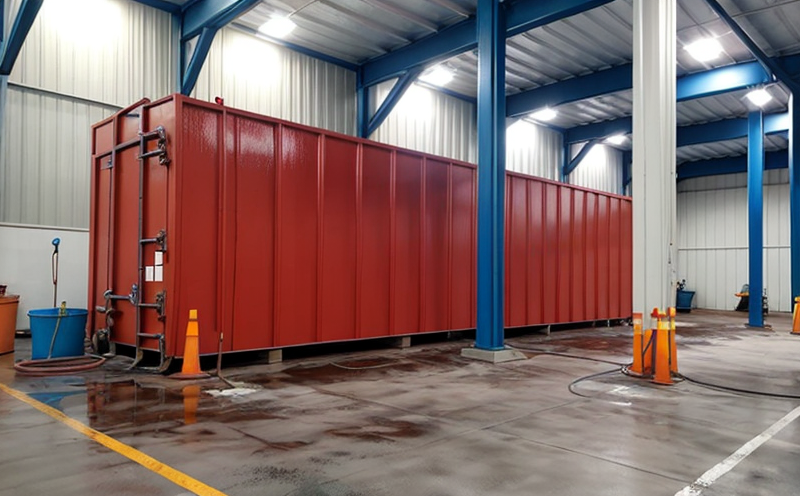EN ISO 7783 Water Vapor Permeability Testing of Coatings
The EN ISO 7783 standard provides a method for determining the water vapor permeability (WVP) of coatings, paints, and other barrier materials. This test is critical in ensuring that industrial products maintain their integrity under various environmental conditions, particularly those involving humidity and moisture.
Water vapor permeability testing is essential in industries such as automotive, aerospace, construction, and electronics. It helps to determine how well a coating can resist the ingress of water vapor, which can lead to corrosion, degradation, or loss of functionality if not properly addressed. The test involves creating a sample specimen that undergoes exposure to controlled humidity levels. After the exposure period, the specimen is weighed to measure any increase in mass due to absorbed moisture.
The EN ISO 7783 method typically uses a gravimetric technique with specimens cut into specific sizes and shapes (usually rectangular strips). The specimens are exposed to a humidified atmosphere for a set duration. After exposure, they are dried and reweighed. The increase in mass is then used to calculate the water vapor permeability value.
This testing procedure allows manufacturers to select coatings that provide adequate protection against moisture while ensuring they meet performance requirements for both indoor and outdoor applications. By adhering to this standard, organizations can ensure their products meet international quality standards and regulatory compliance.
The gravimetric method described in EN ISO 7783 is widely used due to its simplicity and reliability. However, it requires precise control of environmental conditions such as temperature, humidity, and time exposure periods. Proper specimen preparation is also crucial for accurate results. Specimens must be cut accurately according to the standard's specifications and should be representative of the intended coating application.
Understanding the importance of water vapor permeability testing helps quality managers and compliance officers ensure their products meet performance expectations in harsh environments. R&D engineers can use this information to design coatings that offer optimal protection against moisture ingress while maintaining other desired properties like adhesion, flexibility, and durability.
The results from EN ISO 7783 water vapor permeability tests are used by procurement teams to select suppliers who produce reliable and high-performance materials. These insights contribute significantly to the overall quality control processes within manufacturing facilities.
Industry Applications
| Industry | Application |
|---|---|
| Aerospace | Ensuring coatings protect against moisture in high-pressure environments. |
| Automotive | Evaluating the effectiveness of protective coatings used on vehicles exposed to rain and humidity. |
| Construction | Determining whether building materials have adequate protection from moisture intrusion during installation. |
| Electronics | Testing protective coatings for electronic devices that may encounter humid conditions during operation. |
| Pharmaceuticals | Evaluating packaging materials used to store and transport products in various humidity levels. |
| Marine | Assessing the performance of coatings applied to ships, boats, and other marine structures exposed to saltwater environments. |
The EN ISO 7783 water vapor permeability test plays a vital role in ensuring industrial products maintain their integrity under varying environmental conditions. By providing accurate measurements of how much moisture passes through coatings or other barrier materials, this standard helps manufacturers identify suitable protective coatings for specific applications.
Why Choose This Test
Selecting the appropriate water vapor permeability test is crucial when designing industrial products that need to withstand exposure to moisture. EN ISO 7783 offers a standardized approach that ensures consistent and reliable results across different laboratories.
The gravimetric method used in this standard provides precise measurements of water vapor transmission rates, which are essential for selecting coatings that meet performance requirements. This ensures that the chosen coating will effectively protect against moisture ingress while maintaining other desired properties like adhesion, flexibility, and durability.
By adhering to EN ISO 7783, manufacturers can ensure their products meet international quality standards and regulatory compliance. This builds trust with customers who demand high-performance materials capable of performing reliably in harsh environments.
The test also helps procurement teams select suppliers who produce reliable and high-performance materials. With accurate data from this testing method, organizations can make informed decisions about which coatings to use for specific applications.
In addition to its technical benefits, EN ISO 7783 water vapor permeability testing contributes significantly to the overall quality control processes within manufacturing facilities. It allows companies to identify potential issues early in the design phase and implement corrective actions before production begins.
Overall, choosing this test ensures that industrial products maintain their integrity under varying environmental conditions while meeting both performance expectations and regulatory requirements.
Environmental and Sustainability Contributions
The EN ISO 7783 water vapor permeability testing plays a crucial role in promoting sustainability by helping manufacturers design products that minimize environmental impact. By ensuring coatings effectively protect against moisture ingress, this standard contributes to longer product lifecycles and reduced waste.
Effective protection from water vapor is essential for maintaining the structural integrity of industrial components exposed to harsh environments. When materials are protected properly, they require less frequent replacement, reducing the amount of raw materials needed over time. This leads to significant reductions in energy consumption associated with manufacturing processes as well as lower greenhouse gas emissions.
Furthermore, using EN ISO 7783-compliant coatings helps prevent premature degradation of products due to exposure to moisture or other environmental factors. This not only extends the useful life of industrial assets but also reduces maintenance costs and downtime caused by failures related to corrosion or structural damage resulting from poor protection.
Sustainable manufacturing practices supported by rigorous testing standards like EN ISO 7783 contribute positively towards achieving global sustainability goals set forth by organizations such as the United Nations Environment Programme (UNEP). These efforts help reduce resource depletion while promoting circular economy principles through extended product lifecycles and minimized waste generation.





